Cities: Skylines II Feature Highlight #12: Sound & Music
Hi everyone and welcome back! Today we delve into the world of sound and music in Cities: Skylines II. The sounds follow in the footsteps of the game’s predecessor with all the familiar basic elements: City Service building sounds, atmospheric sounds, and the sound of traffic, however, all these elements have been expanded to give more depth, variety, and control. Ambient sounds generate the overall mood and feeling in the game while sound effects provide information and support in a more dynamic manner. After sound effects, we explore how the main menu music for Cities: Skylines II was created and take a look at the radio. All of the in-game music is handled by the radio feature which, along with other sounds, has been expanded compared to Cities: Skylines. The game also now has even more audio options to help you tailor the soundscape to fit your personal preferences.

Tweak your audio experience in the Options Audio section Before we get into all the details of sound and music in Cities: Skylines II you might want to check out the feature highlights video below and have a little listen for yourself.
Sound
City Service buildings are the focus of audio in Cities: Skylines II. Almost all Service Buildings and their upgrades have unique sounds that reflect the building's functionality but also provide more detailed information about the building's operational status. Additionally, building sounds now have short, randomized audio spots together with their sound loops to create an interesting and varied building sound. Because Cities: Skylines II features much larger buildings some buildings host a dynamic audio source. This source reacts to the camera position so that the building audio can be heard properly in every corner in even huge building complexes. Building sounds can also react to the time of day, temperature, and other building conditions based on the building’s functionality, and attaching new building upgrades often adds new building sounds. As a few examples, school buildings are silent during the night and birdsong can only be heard when the temperatures are above a certain threshold. Signature Building audio is divided into categories based on the building types. Each building type has an audio loop that differentiates them from regular zoned buildings.

With audio adjusting to the camera position you can hear the building audio in every part of large buildings such as the Nuclear Power Plant
Ambience
A changing background ambient soundscape is used to create an immersive atmosphere to the city’s overall feel depending on different types of zones, weather, and other occurrences. World ambiance consists of layers that always follow the camera, providing solid background sound for all situations. Changing simulation conditions further affects the ambience, for example, rain isn’t just visible but adds to the ambience sounds.
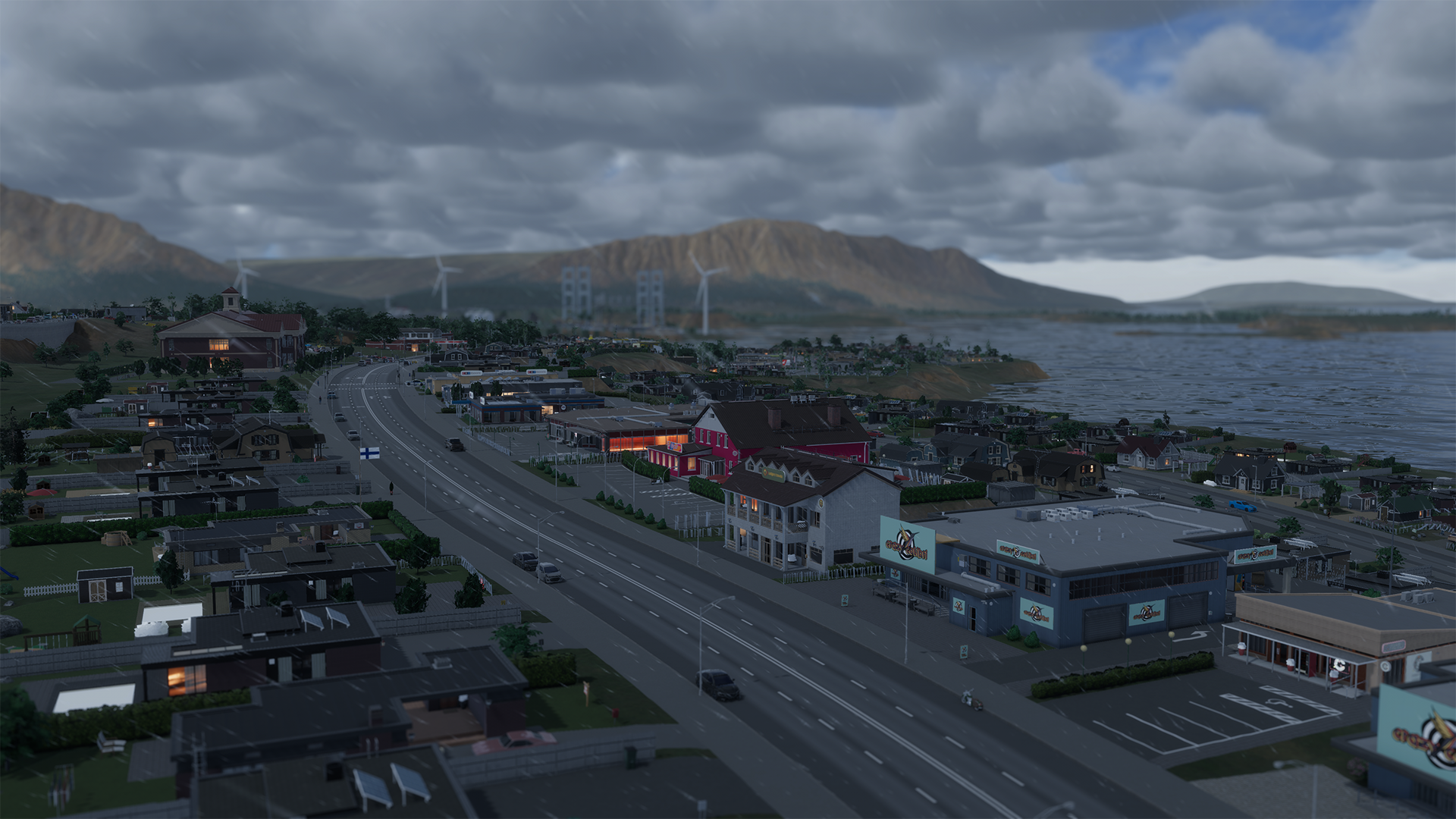
The ambient rain sound helps set the proper mood
Audio Grouping
Two challenges with Cities: Skylines II’s audio were the number of audio sources and the transition between near and far sounds. As a solution, the game now recognizes distance and number of audio sources in relation to the camera. This is called audio grouping, and it is designed to reduce the number of potential audio sources being active at the same time so you aren’t overwhelmed by the sound of 100 cars as you move around your city. The game switches between close and distant audio based on the camera position and the number of audio sources in its proximity. This system allows you to hear the sounds of traffic from a much greater distance, such as a busy highway from afar. Audio grouping also allows zoned areas to sound distinctive. The sound heard depends on the distance of the camera from the area in question. As an example, observing a busy commercial zone from a distance sounds different from observing it close by and the amount of stores directly affects the sound.

The sound of traffic fades into the background as you move further away from the source
Vehicles, Citizens & Animals
We have put emphasis on vehicle and traffic sounds as they are a core part of your city. Vehicle audio changes based on the speed of the vehicle and a style variation for vehicle sirens is chosen automatically based on the theme. Finally in order to align with a more personalized touch for the citizens, selecting a citizen from the city plays a small audio cue. These audio cues reflect the citizen’s age, gender, and mood. Similarly, selecting any animal in the city plays a small audio cue related to the type of animal selected.

Fido is all bark and no bite
Music
Jonne Valtonen is a Finnish composer who together with Jani Laaksonen wrote the music Cities: Skylines, and we’re excited for you to hear what he has created for Cities: Skylines II. We asked Jonne to talk about his work and process for the music and here is what he had to share: “It had already been some years since I wrote the music to the first Cities: Skylines with Jani Laaksonen, when Mariina Hallikainen contacted me and told me that they at Colossal Order are working on a new game. They were wondering if I would be interested in writing music for their new game as well. Naturally, I agreed, especially as Colossal Order has some seriously nice people working in the company and I remembered our previous collaboration with great warmth - simply writing for the first Cities: Skylines was a blast. I was asked to write two pieces for this new game. The first piece was for the Menu that would introduce an identifiable, light, and carefree theme. The second piece was a longer Themes piece that would feature the main theme as well as different themes and textures for different times of the day. I was sent some videos and rough concept art from the game and from that point I started to work on the theme. I was told that the next game was also going to be a city-building game, so this was something I picked as a backbone for the music. City building takes time and things evolve gradually and this is what I wanted the music to reflect. There were a couple of production meetings where I introduced possible themes. They seemed to like one but they felt it wasn't quite there yet. It was agreed that with some small tweaks, it could be the one. I revised the theme a bit (and yes, the theme got better) and then the main theme was liked by all parties, approved, and ready to be used on the music. The theme has identifiable, different, and clear motivic sections that I could use as building blocks. Either to be used as an accompaniment, as a secondary theme, in inner voicings, as a textural and rhythmical reference, or basically anywhere. That is why writing a great melody is hard for me. Not just to have a great hold on the melody itself, but to have a melody that has an motivic identity that can be spanned and sprinkled throughout the soundtrack. This glues the game itself together (that you might be consciously or subconsciously aware) and gives the game a more coherent outlook.
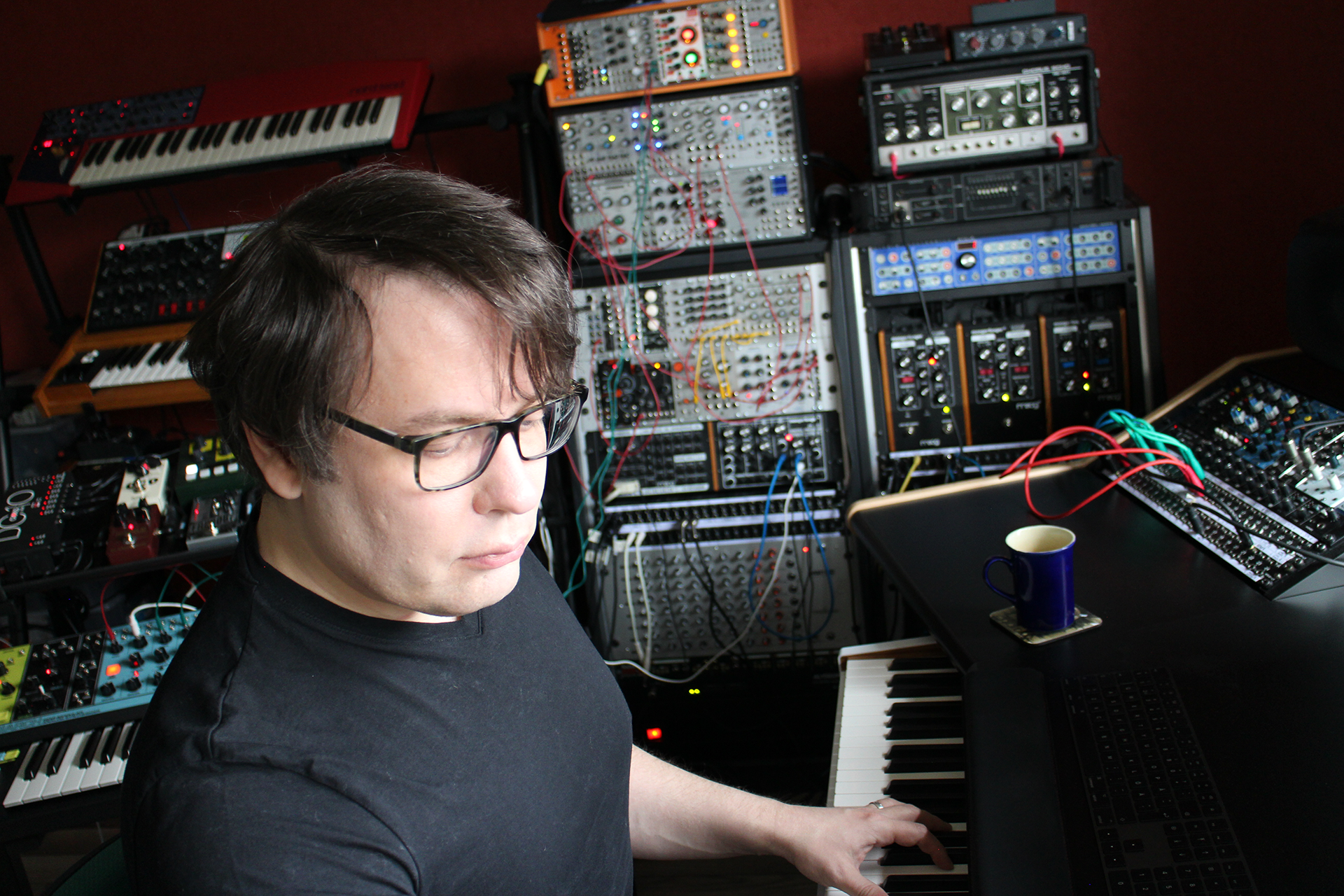
Meet Jonne Valtonen, the composer of the music in Cities: Skylines II. Photo by Nelli Nyman.
The Process
At first, we made the music like we did it for the first game. I wrote and orchestrated the music with Sibelius notation software and Jani Laaksonen converted the score with sample libraries and skillful mixing sounding like it should. I have known Jani already for quite some time, from the time when we were studying composition together, so he is very comfortable with notes and knows the intent. I prefer working this way as when the sample template on my DAW (digital audio workstation) grows large, I tend to lose myself to the programming. This way I can focus more on the music and how the music progresses (horizontal) and then Jani can focus more on the programming (sample libraries) and the mixing, making everything sound perfect (vertical). After some tweaking and demoing we finished the pieces and everybody was happy. I just casually happened to mention to Mariina that I have some pretty good contacts with the Tampere Philharmonic Orchestra (TPO) as I had just written a couple of quite large commissions for them. How cool would it be if our local orchestra would do the soundtrack?! Our local orchestra just happens to be a very high-caliber instrument and oozes with quality, so the end result would be stellar! This could be done with a little editing of the music as the scores are basically already written - because of the way I and Jani work. Colossal Order is also located in Tampere so Mariina got quite excited about the idea, and off we went! I contacted the TPO orchestra manager, but sadly just couldn’t make the schedule work. City orchestras are quite busy and their programming sometimes spans over several years, so I knew this was a bit of a long shot, but it was still a bit of a letdown. Colossal Order continued liking the (real) orchestra approach, and as I had quite a lot of orchestra contacts throughout Europe, I started to look for an orchestra that would match the budget and would be able to perform and record these two pieces, despite our somewhat strict timetable. Finally, through the contacts of producer Thomas Böcker, we found a very high-quality orchestra from Germany. Staatskapelle Weimar is one of the oldest and most traditional orchestras in the world, so I felt very excited that they were able to take on the recording process! The score and the parts got polished and were sent to the conductor, Eckehard Stier, as well as to Holger Busse of the GENUIN recording group who recorded and mixed the music. The recording was done at a time when the pandemic kept opening and closing the concert halls, and we were a bit worried if the recording would happen at all. Luckily when it was time to record, everything was okay and the recording could take place. I wasn’t able to fly to Weimar though due to Covid restrictions, but I followed and commented closely via Skype with the engineer and the conductor. I had a direct audio link so that I was able to listen to the orchestra in real-time. It was almost like sitting in the control room of the studio. We recorded everything in one day (2x3h sessions) and I must say, I was quite amazed at the quality of the orchestra and the recording team! So there you have them. Two pieces. I hope that you enjoy them. I used quite a lot of time for writing these pieces and personally couldn’t be happier with how everything turned out. I think having a real orchestra performance takes your ears and feelings to the next level as it throws this wonderfully organic sheen with a human touch over the music. There are more than 70 players in this orchestra, of whom each musician is a master of their own instrument, with possibly decades of experience listening to each other and playing together as one unit. This is something that, in my opinion, is extremely hard, if not impossible, to achieve with sample based music making.
Menu
On the Menu piece, you hear an opening fanfare, after which the music settles (on which some seemingly random woodblocks are building in the background!). The main theme is then introduced by a clarinet and the further you go with the piece, the more the theme gets “built up”. Now solo instruments are introduced and everything gets bigger and bigger until finally, the music reaches a loud, bright, and majestic point in which the brass section plays out the main theme in its full glory. Things settle - the build is complete. The music opens with the menu immediately after the game is turned on. This is the first introduction to the game, so usually one needs to be a bit careful with the composition. I like to start things more on the calm side so that if you want to go directly to the actual game without being bothered by anything too much, you can do it. On the other hand, if you want to stay on the menu and take care of all things menu, then you have something identifiable and nice that is growing in the background. Of course, there is the one-shot fanfare when you first turn on the game, but otherwise, there is plenty of time to go into the game itself before the music makes itself heard. In general, the music demands more and more attention as it progresses just to say: go and play already!
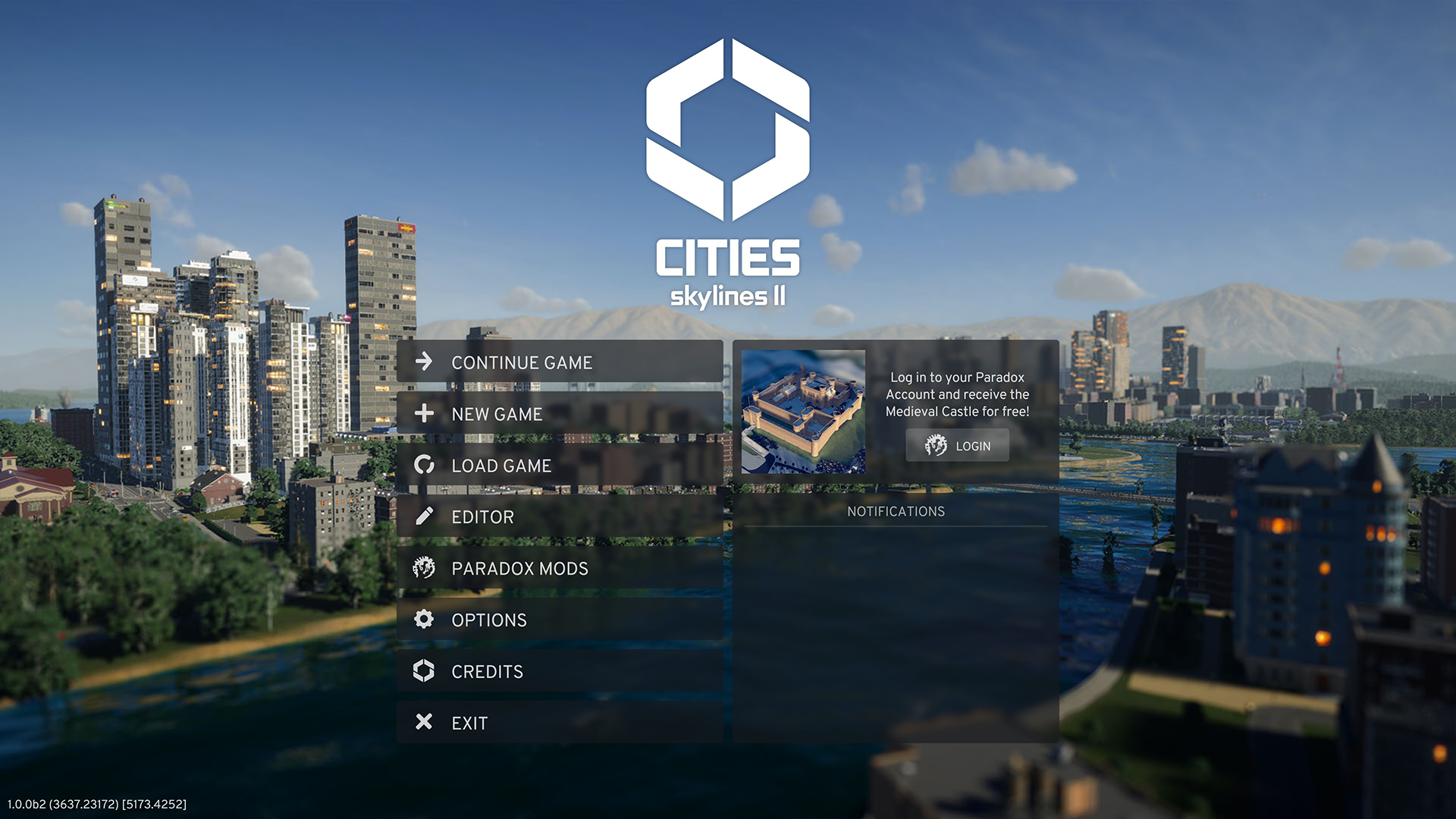
The menu greets you with a fanfare before introducing the main theme
Themes
The Themes piece would introduce three different themes for different times of the day. This piece would not be used in the game but to showcase different thematic and textural materials. These are the day (main theme), evening, and night themes. The piece starts with a fanfare, as does the menu music. After the fanfare, the day theme starts out quite innocent and small. I had this idea that it is the dawn of the build and I am showing you the tools (= the theme) that the music will be built on. When the music progresses you get more instruments joining the overall flow - sometimes playing more soloistically and sometimes more as a group. After a grand iteration of the day theme, things settle. The evening is upon us. A bit mysterious and as things start to darken, you get a new evening theme introduced by the horn section while the tuba provides the bass. This mysterious, but still bright music paints the evening sky. And as always, the evening turns into a night. Now you have yet another theme introduced. And yes. It’s party time. The partying drives throughout the night and drives directly to the biggest iteration of the day theme. The whole orchestra joins the celebration and everything ends with a big and festive bang!”
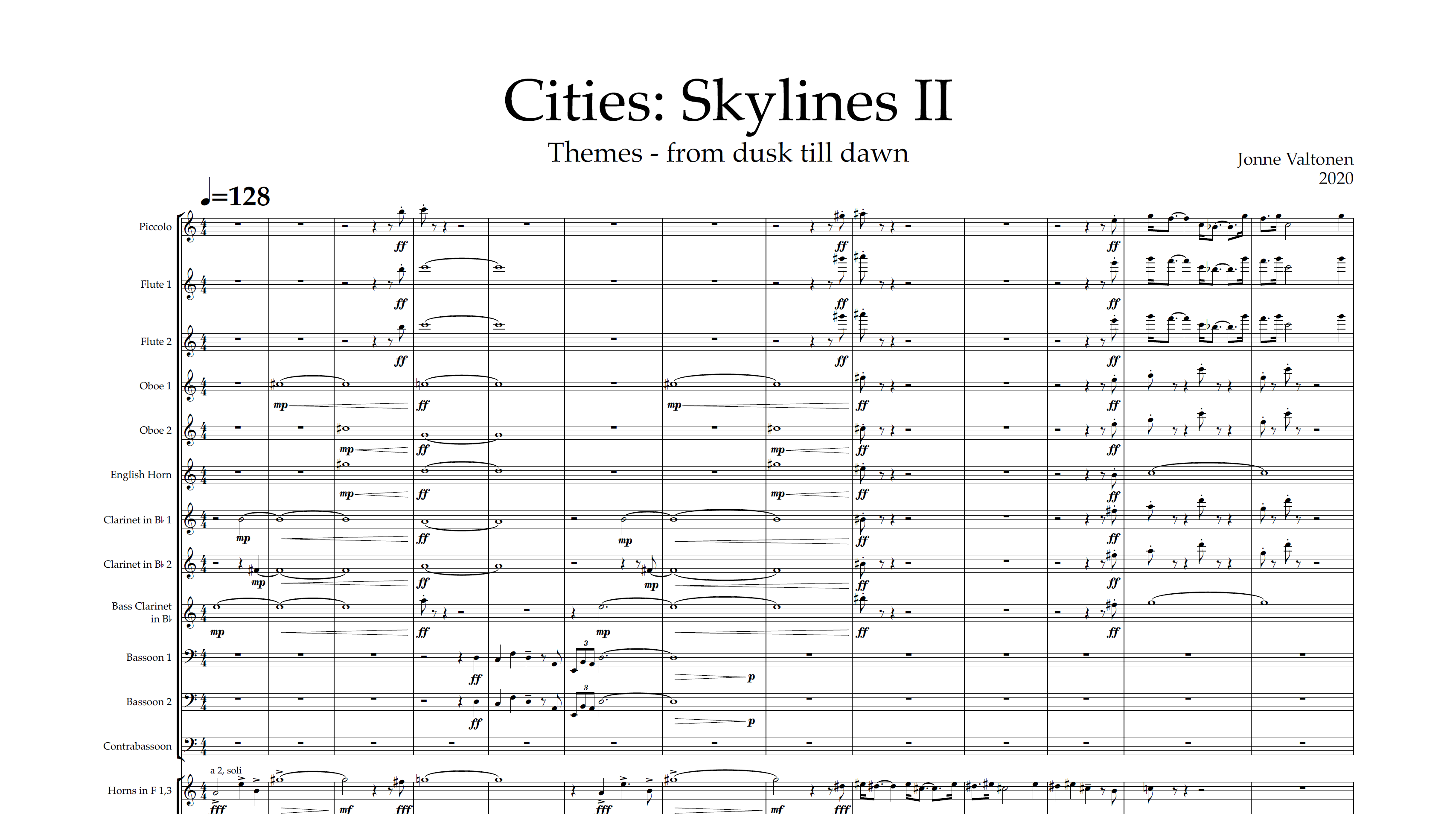
A sneak peek at the sheet music for Cities: Skylines II Thank you to Jonne for joining our development diary and bringing an amazing theme to Cities: Skylines II. We can’t wait for you to enjoy it as you create your cities.
Radio
Cities: Skylines II has two radio networks which are the top category for radio functionality. The networks function as station collections and the biggest difference is the type of content they have between the songs. Public Citizen Radio is a public network that leans a bit more toward classical and miscellaneous popular music. The public network plays public service announcements but has no ads. Urban City Radio is a commercial network, themed more around popular music. The commercial network plays ads but has no public service announcements. Each network has a selection of radio stations under it which all represent a certain music genre or style. The two stations have a host who is the heart of the station and anchor the show. The game also includes a music-only station for those of you who prefer it.
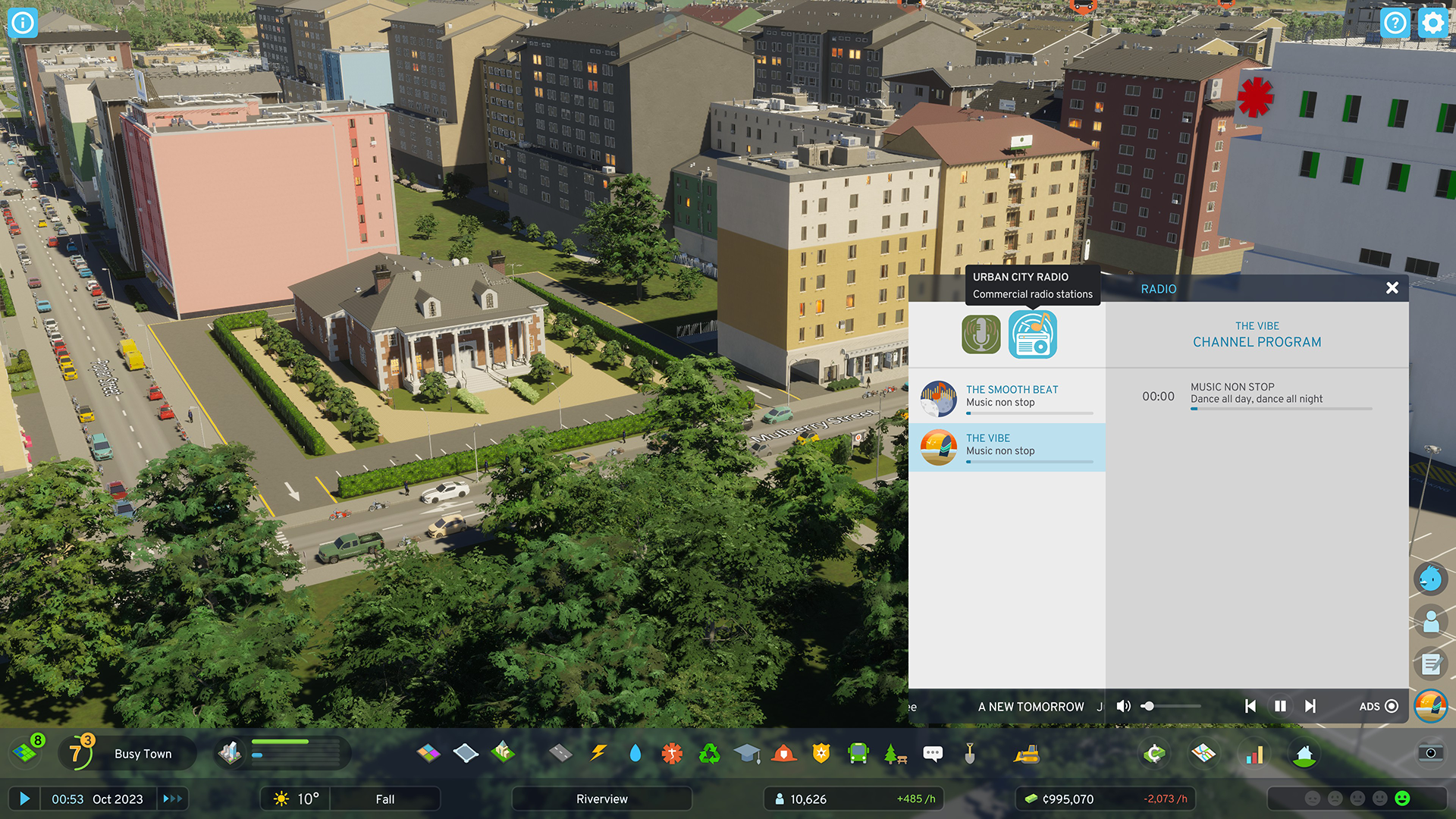
Pick your favorite station in the Radio panel In addition to playing music, station talk shows, and ads the new radio system is capable of more intricate behavior that can take simulation conditions into account. For example, the radio can play news and public service announcements, which are fact-based and informative clips about the events and problems in the city. When a disaster strikes the player hears a disaster-related radio announcement from the radio which interrupts the current radio broadcast. A disaster alarm is also emitted from the Early Disaster Warning System Building if the player has the building in their city. As a result, the radio can provide both entertainment while you work in your city and highlight important information or critical situations you need to address.

Emergency broadcasts are visible in the mini-player which can take you directly to the site of the disaster We hope you enjoy the new sound and music additions to Cities: Skylines II, whether you follow citizens around and experience the ambience of the city, get into your building groove with the radio stations, or hang around the main menu enjoying the game’s theme. That’s all we had for this week’s development diary, but we’re back next week with an introduction to the Cinematic Camera & Photo Mode.








